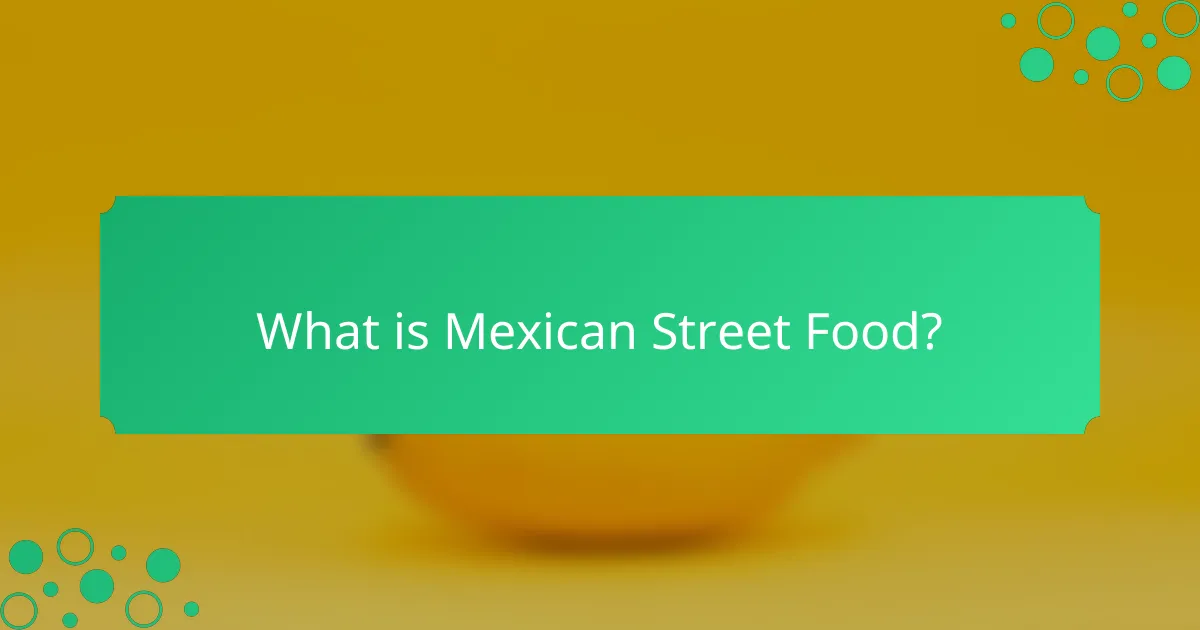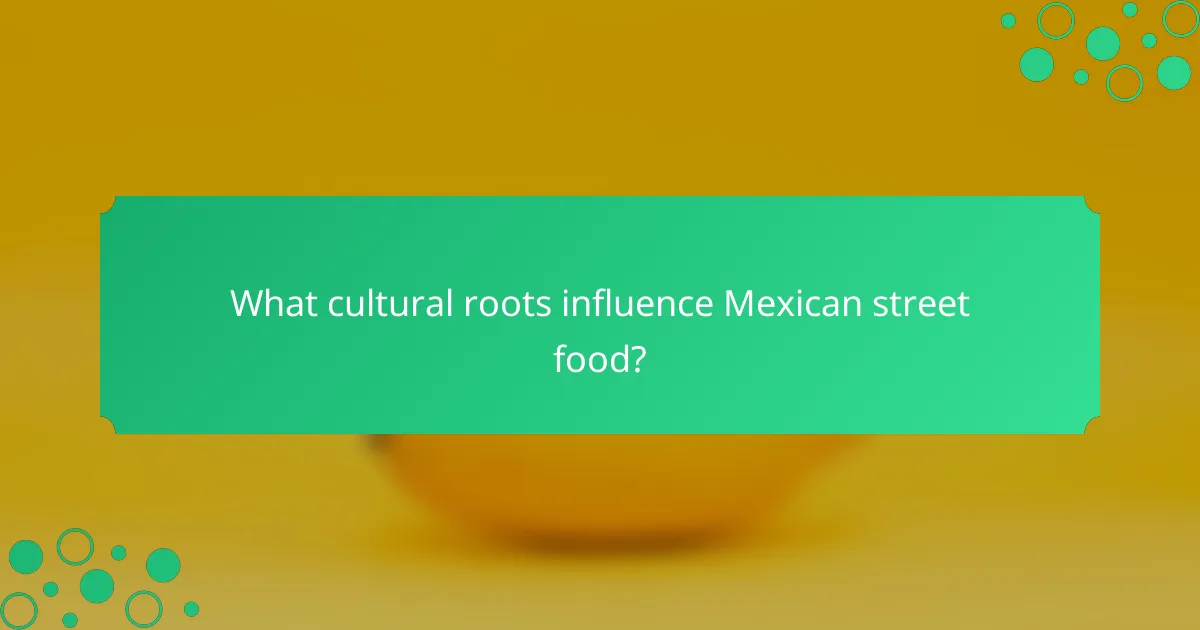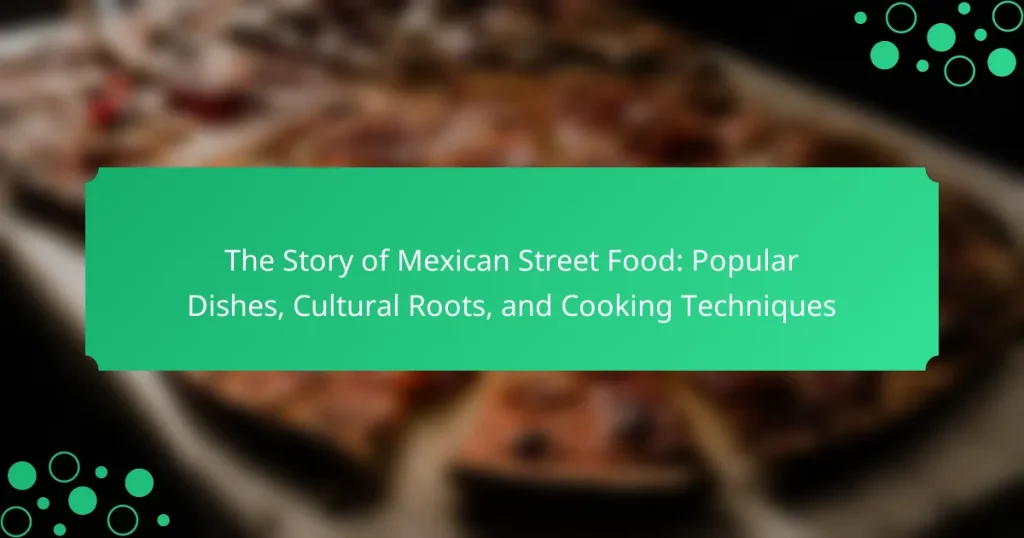Mexican street food encompasses a diverse range of affordable and flavorful dishes sold by vendors in public spaces, including popular items such as tacos, tamales, and elotes. This cuisine reflects Mexico’s rich culinary traditions and showcases regional variations that highlight local ingredients and flavors. The article explores the historical significance of street food as a staple for working-class Mexicans, its cultural heritage, and the influence of various immigrant cultures on its development. Additionally, it examines the cooking techniques commonly used in preparing these dishes, such as grilling, frying, steaming, and roasting, which contribute to the vibrant offerings found in Mexican street food today.

What is Mexican Street Food?
Mexican street food is a diverse array of inexpensive, flavorful dishes sold by vendors in public spaces. It often includes items like tacos, tamales, and elotes. These foods reflect the rich culinary traditions of Mexico. Many dishes have regional variations, showcasing local ingredients and flavors. Street food is not just about taste; it also represents cultural heritage and community. Historically, street food has been a staple for working-class Mexicans. It provides quick, accessible meals for busy lifestyles. The popularity of Mexican street food has grown internationally, influencing global cuisine.
How did Mexican street food evolve over time?
Mexican street food evolved through historical influences, cultural exchanges, and regional adaptations. Indigenous peoples initially created diverse dishes using local ingredients. Spanish colonization introduced new foods, such as wheat and pork, which transformed traditional recipes. Over time, street vendors emerged in urban areas, offering affordable and accessible meals. The rise of cities in the 20th century further popularized street food, with vendors adapting to modern tastes. Today, Mexican street food reflects a fusion of traditional and contemporary flavors. Popular items include tacos, tamales, and elotes, each showcasing the rich culinary heritage. The evolution continues as food trucks and culinary festivals promote street food culture globally.
What historical influences shaped Mexican street food?
Mexican street food is shaped by various historical influences. Indigenous cultures contributed foundational ingredients such as corn, beans, and chilies. The Aztecs and Mayans used these staples in their daily diets. Spanish colonization introduced new ingredients like pork, rice, and spices. This fusion created diverse culinary practices. Additionally, migrations and trade routes influenced regional variations. For example, the introduction of wheat led to the creation of tortillas and tamales. Over time, street food evolved into a vibrant expression of Mexican culture. Each dish tells a story of its historical roots and cultural significance.
How do regional differences impact the types of street food available?
Regional differences significantly impact the types of street food available. Each region of Mexico showcases unique ingredients and culinary traditions. For instance, coastal areas emphasize seafood dishes like ceviche. In contrast, central regions focus on corn-based items such as tamales and tacos. Northern Mexico is known for its grilled meats, reflecting the influence of ranching culture. Local climate and agriculture also dictate ingredient availability, shaping street food offerings. Historical influences, such as indigenous practices and colonial heritage, further diversify the food landscape. This results in a rich tapestry of flavors and preparations unique to each region.
What are the key characteristics of Mexican street food?
Mexican street food is characterized by its vibrant flavors, variety, and accessibility. It often features fresh ingredients like corn, beans, and meats. Common dishes include tacos, tamales, and elotes. Street vendors prepare food quickly and serve it in portable formats. This cuisine reflects regional diversity across Mexico. Spices and herbs enhance the taste, contributing to its popularity. Many dishes are deeply rooted in cultural traditions. The street food scene fosters community interaction and socialization.
What ingredients are commonly used in Mexican street food?
Common ingredients in Mexican street food include corn, beans, and various meats. Corn is often used in tortillas, tamales, and elotes. Beans provide protein and are commonly found in tacos and burritos. Various meats, such as pork, beef, and chicken, are grilled or slow-cooked for tacos and tortas. Additionally, fresh ingredients like cilantro, onions, and lime are used as toppings. Spices like chili powder and cumin add flavor to many dishes. These ingredients reflect traditional Mexican cuisine and its cultural significance.
How does the preparation method differ from traditional cooking?
Mexican street food preparation methods differ from traditional cooking primarily in speed and simplicity. Street food often involves quick cooking techniques such as grilling, frying, or steaming. These methods allow vendors to serve food rapidly to customers. Traditional cooking may involve longer processes like braising or slow cooking. Street food emphasizes fresh ingredients and bold flavors, often using local produce and spices. This approach contrasts with traditional recipes that may require extensive preparation and cooking time. Additionally, street food is typically prepared in open-air settings, enhancing the communal dining experience.

What are some popular Mexican street food dishes?
Tacos, quesadillas, and elote are popular Mexican street food dishes. Tacos consist of corn or flour tortillas filled with various ingredients. Common fillings include meats, beans, and vegetables. Quesadillas are made with tortillas filled with cheese and other ingredients, then grilled. Elote is grilled corn on the cob, typically slathered with mayonnaise, cheese, and chili powder. These dishes are widely enjoyed across Mexico and are integral to its street food culture. They reflect regional flavors and cooking techniques, showcasing the diversity of Mexican cuisine.
What are the most iconic street food dishes in Mexico?
Tacos are the most iconic street food dishes in Mexico. They consist of a tortilla filled with various ingredients. Common fillings include meats, beans, and vegetables. Tacos al pastor is particularly famous, featuring marinated pork. Another iconic dish is elote, grilled corn on the cob, often topped with cheese and chili. Quesadillas are also popular, made with tortillas filled with cheese and other ingredients. Tamales, made of masa and filled with meats or sweets, are a traditional street food. These dishes reflect Mexico’s rich culinary heritage and regional diversity.
How is Tacos al Pastor prepared and served?
Tacos al Pastor are prepared by marinating pork in a blend of spices, including achiote, and citrus juices. The marinated meat is then stacked on a vertical spit, similar to shawarma. It is cooked slowly, allowing the outer layers to caramelize. Once cooked, the meat is shaved off in thin slices. Tacos al Pastor are typically served on corn tortillas. They are garnished with diced onions, cilantro, and pineapple. A squeeze of lime and salsa are often added for extra flavor. This preparation method reflects a blend of Mexican and Middle Eastern culinary traditions.
What makes Elote a beloved street food item?
Elote is a beloved street food item due to its rich flavor and cultural significance. This Mexican dish consists of grilled corn on the cob, traditionally served with toppings like mayonnaise, cheese, chili powder, and lime. The combination of these ingredients creates a unique taste experience. Elote is often enjoyed at street fairs and local markets, making it accessible to many. Its popularity is also rooted in Mexican tradition, where it has been enjoyed for generations. The vibrant presentation and communal aspect of sharing elote enhance its appeal. Additionally, elote is a versatile dish that can be adapted to various tastes and preferences.
What variations exist among popular dishes?
Variations among popular dishes include regional ingredients, preparation methods, and presentation styles. For example, tacos can be filled with different proteins like beef, chicken, or fish. In Mexico, corn tortillas are commonly used, while in other countries, flour tortillas may be preferred. Enchiladas can vary in sauce, ranging from red to green or mole. Street food vendors may add unique toppings such as pickled onions or fresh cilantro. Additionally, the use of spices can differ significantly, influencing flavor profiles. Dishes like tamales can also vary in filling, including sweet or savory options. These variations reflect local tastes and available ingredients.
How do different regions put their spin on Quesadillas?
Different regions in Mexico have unique interpretations of quesadillas. In Oaxaca, quesadillas often feature Oaxaca cheese and various local ingredients. The Yucatán Peninsula adds achiote paste and cochinita pibil for a distinct flavor. In Mexico City, quesadillas can be filled with a variety of ingredients, including mushrooms and flor de calabaza. Northern regions may use flour tortillas, while southern regions typically prefer corn tortillas. Each region’s quesadilla reflects local agricultural products and culinary traditions. This diversity showcases the adaptability of quesadillas across the country.
What unique ingredients are used in regional Tamales?
Unique ingredients in regional tamales vary significantly across Mexico. For instance, Oaxacan tamales often include mole sauce, which adds rich flavor. In Veracruz, tamales can be made with banana leaves and feature seafood fillings. Yucatán tamales frequently incorporate achiote paste, giving them a distinct color and taste. Northern tamales might use beef or cheese, reflecting local preferences. Each region’s unique ingredients highlight the diverse culinary traditions found in Mexican street food. These variations are rooted in local agriculture and cultural influences.

What cultural roots influence Mexican street food?
Mexican street food is influenced by indigenous, Spanish, and other immigrant cultures. Indigenous peoples contributed native ingredients like corn, beans, and chilies. Spanish colonization introduced new foods such as meat, dairy, and spices. African, Caribbean, and Asian immigrants further diversified the culinary landscape. Each cultural influence has shaped unique dishes and preparation methods. For instance, tacos and tamales reflect indigenous roots. Dishes like mole showcase a blend of indigenous and Spanish elements. The fusion of these cultural roots creates the vibrant and diverse offerings found in Mexican street food today.
How does street food reflect Mexican culture and traditions?
Street food reflects Mexican culture and traditions through its diverse flavors and communal nature. It showcases regional ingredients and culinary techniques passed down through generations. Popular dishes like tacos, tamales, and quesadillas highlight Mexico’s agricultural heritage. Street vendors often serve food in vibrant, colorful settings that celebrate local customs. The practice of eating together in public spaces fosters community and social interaction. Festivals and celebrations often feature street food, emphasizing its role in cultural identity. According to a study by the Universidad Autónoma de México, street food is integral to urban life and cultural expression in Mexico.
What role does street food play in community gatherings?
Street food plays a vital role in community gatherings by fostering social interaction. It serves as a communal dining experience that brings people together. Vendors often set up in public spaces, making food accessible to all. The diverse offerings cater to various tastes, enhancing inclusivity. Street food also reflects local culture and traditions, strengthening community identity. Events like festivals often feature street food, attracting larger crowds. This creates opportunities for local businesses to thrive. In Mexico, street food is integral to celebrations, showcasing regional specialties and culinary heritage.
How are festivals and celebrations linked to street food offerings?
Festivals and celebrations are intrinsically linked to street food offerings as they serve as vibrant showcases of local culinary traditions. During these events, street food vendors often highlight traditional dishes that reflect cultural heritage. For instance, in Mexico, street food such as tacos, tamales, and elote are commonly featured during national holidays and local fiestas. These foods not only provide sustenance but also enhance the festive atmosphere. The presence of street food at celebrations fosters community engagement and social interaction among attendees. Additionally, many street food offerings are prepared using age-old recipes passed down through generations, emphasizing cultural identity. This connection between festivals and street food is evident in the way these culinary experiences are celebrated and enjoyed collectively.
What are the social implications of street food in Mexico?
Street food in Mexico has significant social implications. It serves as a vital source of income for many families. Street vendors often belong to lower socioeconomic classes. This economic opportunity helps reduce poverty levels in urban areas. Additionally, street food fosters community interaction and social cohesion. People gather around food stalls, creating social networks. The diversity of street food reflects cultural heritage and identity. Traditional recipes are passed down through generations, preserving culinary traditions. Street food also highlights issues of regulation and public health. Vendors often face challenges related to permits and sanitation standards. Overall, street food plays a crucial role in the social fabric of Mexican society.
How does street food contribute to local economies?
Street food significantly contributes to local economies by creating jobs and generating income. Vendors often require minimal startup costs, allowing entrepreneurs to enter the market easily. This accessibility promotes small business growth within communities. Street food also attracts tourists, increasing foot traffic and sales for nearby businesses. According to a report by the World Bank, street food contributes to approximately 2.5% of the GDP in some developing countries. Additionally, local farmers benefit from street food vendors purchasing fresh produce, enhancing agricultural sales. Overall, street food fosters economic activity and supports community development.
What challenges do street food vendors face in urban areas?
Street food vendors in urban areas face numerous challenges. Regulatory hurdles often limit their ability to operate legally. Many cities require permits that can be costly and difficult to obtain. Health and safety regulations also impose strict standards that vendors must meet. Compliance with these regulations often requires additional investments in equipment and training. Competition is another significant challenge. Vendors must differentiate themselves in crowded markets. Economic factors, such as rising costs of ingredients, can impact profitability. Additionally, urban environments may pose logistical issues, including limited access to suitable locations and transportation difficulties. Weather conditions can also affect sales, as outdoor operations are vulnerable to rain or extreme heat.

What cooking techniques are used in Mexican street food?
Mexican street food utilizes various cooking techniques. Common methods include grilling, frying, steaming, and roasting. Grilling is often used for meats like tacos al pastor. Frying is prevalent for snacks such as churros and quesadillas. Steaming is employed for tamales, which are wrapped in corn husks. Roasting is a technique used for vegetables and meats, enhancing their flavors. These techniques reflect traditional practices and regional variations in Mexican cuisine.
What are the most common cooking methods for street food?
The most common cooking methods for street food include grilling, frying, steaming, and boiling. Grilling is popular for items like tacos al pastor, where marinated meat is cooked over an open flame. Frying is frequently used for snacks like churros and quesadillas, providing a crispy texture. Steaming is often seen in dishes such as tamales, allowing for even cooking and moisture retention. Boiling is used for making soups and broths, which are essential in many street food offerings. These methods highlight the versatility and richness of flavors in Mexican street food.
How does grilling enhance the flavors of street food?
Grilling enhances the flavors of street food by imparting a smoky taste and creating a charred exterior. The high heat caramelizes sugars in the food, intensifying its natural flavors. It also adds depth through the Maillard reaction, which occurs when proteins and sugars react under heat. This reaction generates complex flavor compounds. Grilling allows for the escape of excess moisture, concentrating the taste. Additionally, the grilling process can infuse food with marinades and spices, enhancing overall flavor profiles. Studies show that grilled foods often have higher consumer preference due to these enhanced flavors.
What is the significance of frying in Mexican street food preparation?
Frying is significant in Mexican street food preparation due to its impact on flavor, texture, and preservation. The frying process enhances the taste of various ingredients, creating a crispy exterior that complements soft interiors. This technique is essential for dishes like tacos dorados and churros, where the texture is crucial. Frying also allows for quick cooking, making it ideal for street vendors who serve food rapidly. Additionally, the high temperatures involved in frying can kill bacteria, contributing to food safety. The method has historical roots in Mexican cuisine, reflecting indigenous cooking practices. Various oils used in frying, such as canola or lard, add distinct flavors to the dishes. Overall, frying is a key technique that defines the sensory experience of Mexican street food.
How can one replicate authentic Mexican street food at home?
To replicate authentic Mexican street food at home, focus on using traditional ingredients and cooking methods. Start by sourcing key ingredients like masa for tortillas, fresh produce, and spices. Prepare dishes such as tacos, elotes, or quesadillas using these ingredients. Use techniques like grilling, frying, or steaming to enhance flavors. For example, grill corn for elotes and season with lime, cheese, and chili powder. Authentic recipes often involve marinating meats and slow-cooking them for deeper flavor. Emphasize fresh salsas and toppings to complete the dishes. Following these steps will bring the essence of Mexican street food into your home kitchen.
What tips should home cooks follow for making street food dishes?
Home cooks should focus on using fresh ingredients and bold flavors when making street food dishes. Fresh produce enhances the taste and authenticity of the dish. Bold spices and seasonings are essential for replicating street food flavors. Street food often features simple preparation methods; home cooks should aim for quick cooking techniques. Presentation matters; vibrant colors and garnishes can elevate the dish. Street food is typically served hot; ensure dishes are served immediately for the best experience. Finally, learning from street food vendors through videos or cookbooks can provide valuable insights into techniques and recipes.
What essential tools and ingredients are needed for authentic preparation?
Essential tools for authentic Mexican street food preparation include a comal, a molcajete, and a tortilla press. A comal is a flat griddle used for cooking tortillas and roasting ingredients. A molcajete is a stone mortar and pestle, ideal for grinding spices and making salsas. A tortilla press helps create uniform tortillas.
Key ingredients include masa harina, fresh vegetables, various proteins, and spices. Masa harina is the foundation for tortillas and tamales. Fresh vegetables like tomatoes, onions, and cilantro add flavor and texture. Proteins such as chicken, beef, or pork are essential for many dishes. Spices like cumin and chili powder enhance the overall taste.
These tools and ingredients are vital for achieving authentic flavors and textures in Mexican street food. Their historical use in traditional cooking methods reinforces their importance in the culinary process.
Mexican street food is a diverse collection of affordable and flavorful dishes sold by vendors, deeply rooted in the country’s cultural heritage. The article explores the evolution of Mexican street food, influenced by indigenous ingredients and Spanish colonization, highlighting regional variations and popular dishes such as tacos, tamales, and elotes. Key characteristics, cooking techniques, and the social implications of street food are discussed, emphasizing its role in community gatherings and local economies. The article also provides insights into replicating authentic street food at home, focusing on essential tools and ingredients.




